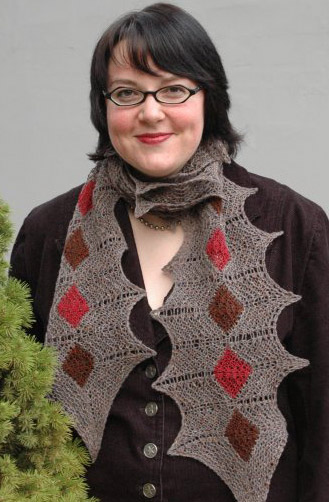

Using
MC and circular
needle, CO 350 sts very loosely. (You may wish
to use a larger needle to CO.)
First Half
Row 1 [RS]: K2tog, k17, ssk, [k2tog,
k4, kfb, kfb, k4, ssk] 22 times, k2tog, k17,
ssk. 346 sts.
Even-numbered Rows 2-14 [WS]: K all
sts.
Row 3 [RS]: K2tog, k15, ssk, [k2tog,
k4, kfb, kfb, k4, ssk] 22 times, k2tog, k15,
ssk. 342 sts.
Row 5 [RS]: K2tog, k13, ssk, [k2tog,
k4, kfb, kfb, k4, ssk] 22 times, k2tog, k13,
ssk. 338 sts.
Row 7 [RS]: K2tog, k11, ssk, [k2tog,
k4, kfb, kfb, k4, ssk] 22 times, k2tog, k11,
ssk. 334 sts.
Row 9 [RS]: K2tog, k9, ssk, [k2tog,
k4, kfb, kfb, k4, ssk] 22 times, k2tog, k9,
ssk. 330 sts.
Row 11 [RS]: K2tog, k7, ssk, [k2tog,
k4, kfb, kfb, k4, ssk] 22 times, k2tog, k7,
ssk. 326 sts.
Row 13 [RS]: K2tog, k5, ssk, [k2tog,
k4, kfb, kfb, k4, ssk] 22 times, k2tog, k5,
ssk. 322 sts.
Rows 15 & 16: K all sts.
Squares
*
Row 1 [RS]: Using double-point needle
and CC1, k5, ssk, k2tog, k5. 12 sts on right
needle. Turn work, leaving rem sts on hold on
circular needle; square will be worked back
and forth over sts on double-point needle.
Even-numbered Rows 2-10 [WS]: K all
sts.
Row 3 [RS]: K4, ssk, k2tog, k4. 10
sts.
Row 5 [RS]: K3, ssk, k2tog, k3. 8 sts.
Row 7 [RS]: K2, ssk, k2tog, k2. 6 sts.
Row 9 [RS]: K1, ssk, k2tog, k1. 4 sts.
Row 11 [RS]: Ssk, k2tog. Place rem
2 sts on hold on safety pin.
Repeat from * until all sts on circular needle
have been worked. Use CC2 for next square; alternate
colors for each following square. There will
be 23 squares in total, last square will be
worked in CC1.
Second Half
Using MC and circular needle, with RS facing,
pick up and k 1 st in edge of last MC garter
ridge before first square, [pick up and k 5
sts along first edge of square (1 st in each
garter ridge), k 2 held sts, pick up and k 5
sts along rem edge of square, pick up and k
2 sts in MC space between squares] 22 times,
pick up and k 5 sts along first edge of last
square, k 2 held sts, pick up and k 5 sts along
rem edge of last square, pick up and k 1 st
in edge of last MC garter ridge of First Half.
322 sts.
Odd-numbered Rows 1-13 [WS]: K all
sts.
Row 2 [RS]: Kfb, k5, kfb, [kfb, k4,
ssk, k2tog, k4, kfb] 22 times, kfb, k5, kfb.
326 sts.
Row 4 [RS]: Kfb, k7, kfb, [kfb, k4,
ssk, k2tog, k4, kfb] 22 times, kfb, k7, kfb.
330 sts.
Row 6 [RS]: Kfb, k9, kfb, [kfb, k4,
ssk, k2tog, k4, kfb] 22 times, kfb, k9, kfb.
334 sts.
Row 8 [RS]: Kfb, k11, kfb, [kfb, k4,
ssk, k2tog, k4, kfb] 22 times, kfb, k11, kfb.
338 sts.
Row 10 [RS]: Kfb, k13, kfb, [kfb, k4,
ssk, k2tog, k4, kfb] 22 times, kfb, k13, kfb.
342 sts.
Row 12 [RS]: Kfb, k15, kfb, [kfb, k4,
ssk, k2tog, k4, kfb] 22 times, kfb, k15, kfb.
346 sts.
Row 14 [RS]: Kfb, k17, kfb, [kfb, k4,
ssk, k2tog, k4, kfb] 22 times, kfb, k17, kfb.
350 sts.
Row 15 [WS]: K all sts. BO very loosely.

